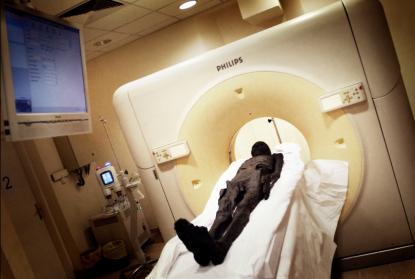2024. May 3. Friday
Budapest Museum of Fine Arts - Budapest
 |
Address: 1146, Budapest Dózsa György út 41.
Phone number: (1) 469-7100
E-mail: info@szepmuveszeti.hu
Opening hours: Tue-Sun 10:00-18:00
|
The exhibition has closed for visitors.
2011.06.09. - 2012.02.19.
Museum tickets, service costs:
|
Ticket for adults
(valid for the permanent exhibitions)
|
2800 HUF
|
/ capita
|
|
Ticket for adults
|
3200 HUF
|
|
|
Group ticket for adults
|
2900 HUF
|
|
|
Ticket for students
(valid for the permanent exhibitions)
|
1400 HUF
|
/ capita
|
|
Ticket for students
|
1600 HUF
|
|
|
Group ticket for students
|
1400 HUF
|
|
|
Ticket for pensioners
(valid for the permanent exhibitions)
|
1400 HUF
|
/ capita
|
|
Audio guide
|
800 HUF
|
|
|
Video
|
1000 HUF
|
The Museum of Fine Arts launched a programme at the beginning of the year aimed at the comprehensive examination of the four mummies preserved in its Egyptian Collection. The objective of the Budapest Mummy Project was to "bring to life" four people who had lived in ancient Egypt, to reveal their past and to determine some of the biological features of the mummified individuals: their former features (facial reconstruction), possible illnesses, the time, cause and circumstances of their deaths, as well as the process and technique used in the mummification of their bodies. During the series of tests natural science and medical-diagnostic methods were applied in addition to Egyptology studies in order to reveal the secrets of the mummified bodies to the greatest possible extent, such applications including computer tomography, biopsy and radio carbon dating tests, and even DNA research. In addition to the staff of the Museum of Fine Arts, radiologists from the Radiological Clinic of Semmelweis University, anthropologists from the Department of Anthropology of the Hungarian Natural History Museum, as well as other researchers linked to the areas of examination also participated in the project.

Until now experts knew little about the four mummies preserved in the museum's collection. Their respective ages, histories, the methods employed in their mummification and causes of death were mostly shrouded in mystery. However, thanks to the recently carried out tests, a great deal of light has being shone upon these questions. Tests conducted upon the mummy known as Rer revealed that she was a female who died between the ages of 20 and 24 in the 3rd to 4th centuries BC, and it was concluded from the fairly shattered condition of her skeleton that her death was probably caused by a serious physical trauma. The researchers were able to place the Hortesnaht mummy into a precise historical and cultural context. The analysis of the coffin's iconography and the CT examination of the mummification technique produced the same results: Hortesnaht's mummy and coffin can be linked to the cemetery complexes connected to the town of Ahmim in the 3rd century BC. The CT scan conducted of the skull made it possible to restore to life the former facial features of Hortesnaht, who passed away over two thousand years ago. The tests carried out on the body of the so-called Szombathely mummy allowed researchers not only to establish the age of the mummy - which on the basis of the radio carbon tests dates from the 2nd-3rd centuries BC - but also to ascertain that it belongs to a cartonnage coffin with a gold plated face already preserved in the collection. Up until now it had been assumed that the mummy had reached Hungary through Count László Almásy, but according to the most recent research it was purchased by Provost Adolf Kunc in Egypt (1896) and donated by him to the Premonstratensian Secondary School in Szombathely. In the case of the so-called unwrapped mummy the determination of its age was the greatest achievement of the researchers. On the basis of the carbon isotope test of a bone sample it can be stated that the mummy was prepared in the later Ptolemaic period in 2nd-1st century BC. The chemical tests identified the dark material covering the body as plant resin, which also substantiates its dating.
The exhibition presents the four mummies linked to four aspects of Egyptian culture: demographics in ancient Egypt: illnesses and death, the technique of Egyptian mummification: preserving the body; preparation for the afterlife: the exterior decorations of Egyptian mummies, as well as ideals and portraits: the representation of personality in ancient Egyptian art. In this section of the show visitors will, thanks to facial reconstruction, be able to see the true facial features of Hortesnaht, who lived in ancient Egypt over two thousand years ago. The examination methods applied in the research on mummies and their primary results will be presented within the four thematic units of the exhibition, while in a separate hall their results will be shown in 3D form, brought alive for the visitor in virtual space.
The 3D film linked to the exhibition was made by Umbrella Post Production and Laboratory Ideas, and the short film that followed the series of tests in the Budapest Mummy Project was directed by Balázs Béla Prize winning Péter Szalay and cinematographed by Ernő Nagy.

Until now experts knew little about the four mummies preserved in the museum's collection. Their respective ages, histories, the methods employed in their mummification and causes of death were mostly shrouded in mystery. However, thanks to the recently carried out tests, a great deal of light has being shone upon these questions. Tests conducted upon the mummy known as Rer revealed that she was a female who died between the ages of 20 and 24 in the 3rd to 4th centuries BC, and it was concluded from the fairly shattered condition of her skeleton that her death was probably caused by a serious physical trauma. The researchers were able to place the Hortesnaht mummy into a precise historical and cultural context. The analysis of the coffin's iconography and the CT examination of the mummification technique produced the same results: Hortesnaht's mummy and coffin can be linked to the cemetery complexes connected to the town of Ahmim in the 3rd century BC. The CT scan conducted of the skull made it possible to restore to life the former facial features of Hortesnaht, who passed away over two thousand years ago. The tests carried out on the body of the so-called Szombathely mummy allowed researchers not only to establish the age of the mummy - which on the basis of the radio carbon tests dates from the 2nd-3rd centuries BC - but also to ascertain that it belongs to a cartonnage coffin with a gold plated face already preserved in the collection. Up until now it had been assumed that the mummy had reached Hungary through Count László Almásy, but according to the most recent research it was purchased by Provost Adolf Kunc in Egypt (1896) and donated by him to the Premonstratensian Secondary School in Szombathely. In the case of the so-called unwrapped mummy the determination of its age was the greatest achievement of the researchers. On the basis of the carbon isotope test of a bone sample it can be stated that the mummy was prepared in the later Ptolemaic period in 2nd-1st century BC. The chemical tests identified the dark material covering the body as plant resin, which also substantiates its dating.
The exhibition presents the four mummies linked to four aspects of Egyptian culture: demographics in ancient Egypt: illnesses and death, the technique of Egyptian mummification: preserving the body; preparation for the afterlife: the exterior decorations of Egyptian mummies, as well as ideals and portraits: the representation of personality in ancient Egyptian art. In this section of the show visitors will, thanks to facial reconstruction, be able to see the true facial features of Hortesnaht, who lived in ancient Egypt over two thousand years ago. The examination methods applied in the research on mummies and their primary results will be presented within the four thematic units of the exhibition, while in a separate hall their results will be shown in 3D form, brought alive for the visitor in virtual space.
The 3D film linked to the exhibition was made by Umbrella Post Production and Laboratory Ideas, and the short film that followed the series of tests in the Budapest Mummy Project was directed by Balázs Béla Prize winning Péter Szalay and cinematographed by Ernő Nagy.
